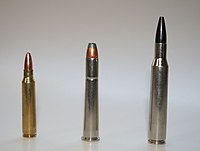.32-40 Ballard
| .32-40 Ballard | ||||||||||||||||||||
|---|---|---|---|---|---|---|---|---|---|---|---|---|---|---|---|---|---|---|---|---|
 .32-40 cartridge between .223 Remington (left) and .270 Winchester (right) | ||||||||||||||||||||
| Type | Rifle | |||||||||||||||||||
| Place of origin | USA | |||||||||||||||||||
| Specifications | ||||||||||||||||||||
| Case type | Rimmed straight | |||||||||||||||||||
| Bullet diameter | .320 in (8.1 mm) | |||||||||||||||||||
| Neck diameter | .338 in (8.6 mm) | |||||||||||||||||||
| Base diameter | .424 in (10.8 mm) | |||||||||||||||||||
| Rim diameter | .506 in (12.9 mm) | |||||||||||||||||||
| Rim thickness | .063 in (1.6 mm) | |||||||||||||||||||
| Case length | 2.13 in (54 mm) | |||||||||||||||||||
| Overall length | 2.59 in (66 mm) | |||||||||||||||||||
| Rifling twist | 1 in 16 | |||||||||||||||||||
| Primer type | Large rifle | |||||||||||||||||||
| Ballistic performance | ||||||||||||||||||||
| ||||||||||||||||||||
| Test barrel length: 20 inches (510 mm) | ||||||||||||||||||||
The .32-40 Ballard (also called .32-40 Winchester)[1] is an American rifle cartridge.
Description
Introduced in 1884, the .32-40 was developed as a black powder match-grade round for the Ballard single-shot Union Hill No. 8 and 9 target rifles. Using a 165-grain (10.7 g) bullet over 40 grains (2.6 g) of black powder (muzzle velocity 1,440 ft/s (440 m/s), muzzle energy 755 ft⋅lbf (1,024 J)), the factory load gained a reputation for fine accuracy, with a midrange trajectory of 11 inches (28 cm) at 200 yd (180 m).[2] It was available in Winchester and Marlin lever rifles beginning in 1886.[2] It stopped being a factory chambering around 1940.[2]
It provides performance sufficient for deer at up to 300 yards (270 m) in a modern rifle, for which it can be loaded to about equal the .30-30.[2] It is more than enough for varmints, including coyotes and wolves, or medium-sized game.
The .32-40 also served as the basis for Harry Pope's wildcat .33-40.
See also
References
Sources
- Barnes, Frank C., ed. by John T. Amber. Cartridges of the World (Northfield, IL: DBI Books, 1972),
